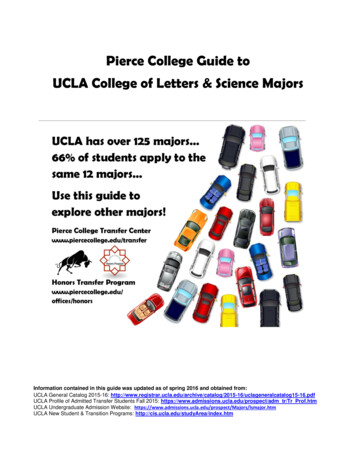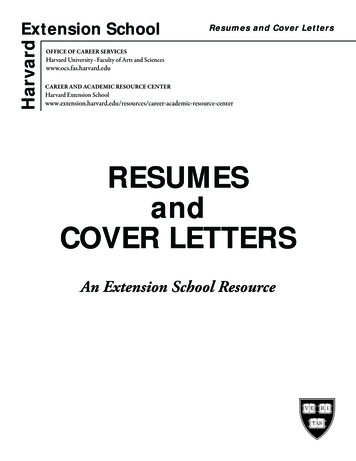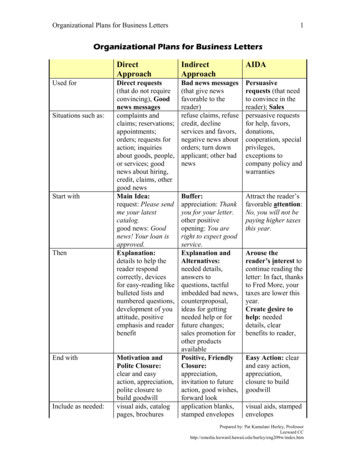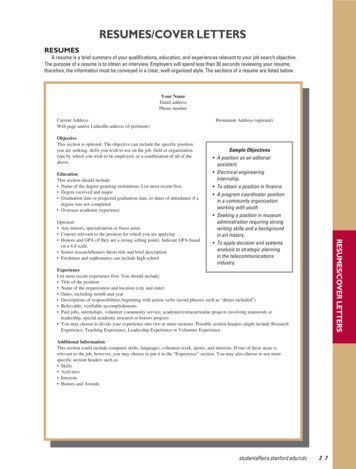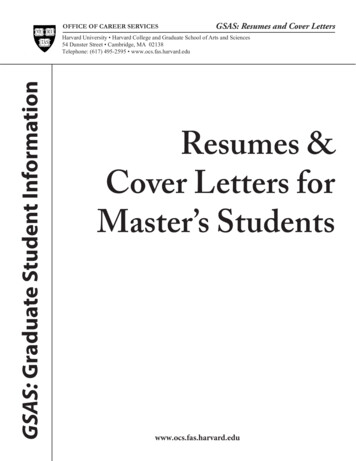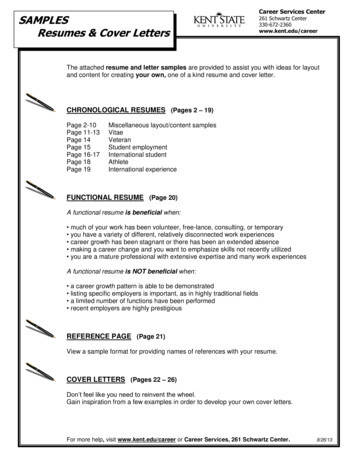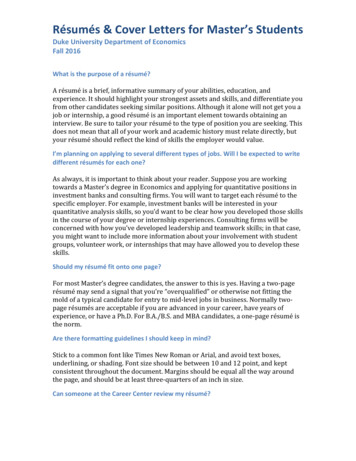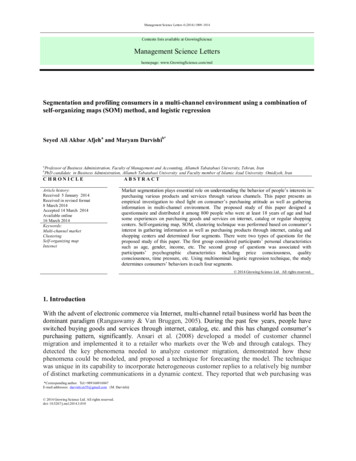
Transcription
Management Science Letters 4 (2014) 1009–1014Contents lists available at GrowingScienceManagement Science Lettershomepage: www.GrowingScience.com/mslSegmentation and profiling consumers in a multi-channel environment using a combination ofself-organizing maps (SOM) method, and logistic regressionSeyed Ali Akbar Afjeha and Maryam Darvishib*abProfessor of Business Administration, Faculty of Management and Accounting, Allameh Tabatabaei University, Tehran, IranPhD candidate in Business Administration, Allameh Tabatabaei University and Faculty member of Islamic Azad University Omidiyeh, IranCHRONICLEArticle history:Received 5 January 2014Received in revised format8 March 2014Accepted 14 March 2014Available online16 March 2014Keywords:Multi-channel marketClusteringSelf-organizing mapInternetABSTRACTMarket segmentation plays essential role on understanding the behavior of people’s interests inpurchasing various products and services through various channels. This paper presents anempirical investigation to shed light on consumer’s purchasing attitude as well as gatheringinformation in multi-channel environment. The proposed study of this paper designed aquestionnaire and distributed it among 800 people who were at least 18 years of age and hadsome experiences on purchasing goods and services on internet, catalog or regular shoppingcenters. Self-organizing map, SOM, clustering technique was performed based on consumer’sinterest in gathering information as well as purchasing products through internet, catalog andshopping centers and determined four segments. There were two types of questions for theproposed study of this paper. The first group considered participants’ personal characteristicssuch as age, gender, income, etc. The second group of questions was associated withparticipants’ psychographic characteristics including price consciousness, qualityconsciousness, time pressure, etc. Using multinominal logistic regression technique, the studydetermines consumers’ behaviors in each four segments. 2014 Growing Science Ltd. All rights reserved.1. IntroductionWith the advent of electronic commerce via Internet, multi-channel retail business world has been thedominant paradigm (Rangaswamy & Van Bruggen, 2005). During the past few years, people haveswitched buying goods and services through internet, catalog, etc. and this has changed consumer’spurchasing pattern, significantly. Ansari et al. (2008) developed a model of customer channelmigration and implemented it to a retailer who markets over the Web and through catalogs. Theydetected the key phenomena needed to analyze customer migration, demonstrated how thesephenomena could be modeled, and proposed a technique for forecasting the model. The techniquewas unique in its capability to incorporate heterogeneous customer replies to a relatively big numberof distinct marketing communications in a dynamic context. They reported that web purchasing was*Corresponding author. Tel: 989166916847E-mail addresses: darvishi.m55@gmail.com (M. Darvishi) 2014 Growing Science Ltd. All rights reserved.doi: 10.5267/j.msl.2014.3.010
1010associated with lower subsequent purchase volumes than when buying from other outlets. In addition,marketing efforts in their survey were associated with channel usage and purchase incidence,offsetting negative Web experience effects; and finally, negative interactions existed between likecommunications. They also reported that over the four-year period of their data, a Web-oriented“migration” segment emerged, and this group maintained higher sales volume. Their post hocanalysis recommended that marketing efforts and exogenous customer-level played essential roles informing these segments.Bhatnagar and Ghose (2004) implemented a latent class modeling technique to segment webshoppers, based on their purchase behavior across various product categories. They also profiled thesegments along the twin dimensions of demographics and different advantages and described thatthey could provide more diagnostic information than mere descriptive demographic profiling. Thestudy shed light on consumer perceptions and behavior with in terms of online commerce. First,consumers were more concerned about web attributes associated with perceived losses than with webattributes that consumers associate with gains. In addition, compared with other online purchaserelated attributes, getting the lowest price did not seem to be a very important attribute for webshoppers. The finding may also state that prices on web pages were somewhat similar, and consumerswere moving on to other criteria to continue their evaluation process.Chandon et al. (2000) proposed a model of the multiple consumer advantages of a sales promotionand explained the implications of the multi-benefit and the benefit congruency frameworks forunderstanding consumer responses to sales promotions. Chen (2003) developed a scheme integratingthe chi-square automatic interaction detection method, which expands the current analytical spectrumof travel segmentation. He also used a case study of college students' spring-break trips to describethe necessary steps of segmenting a population into mutually exclusive subpopulations. Darian (1987)investigated the relationship between demographic characteristics of households and in-homeshopping rates, based on data from the Institute of Retail Management/Management HorizonsShopping Behavior Data Base. They study reported that housewives and part-time female workerswith preschool children, single men less than 40 years old, households where the wife was aged 40–49 yeas, and households in the middle income groups could be the groups who were most likely to bein-home shoppers.Inman et al. (2004) investigated the moderating role of channel-category associations in consumerchannel patronage by contributing to the literature on brand associations to the context of channels.They estimated a model, which builds a link between channel-category associations and consumergeodemographics as well as channel share of volume. The channel-category associations foundsignificant impacts and interaction impacts with channel type and geodemographic factors on channelshare of volume, and they accounted for most of the explained variance (72%) in channel share ofvolume.Kumar and Venkatesan (2005) developed a conceptual model, which determined the customer leveldetails and supplier factors associated with buying behavior across multiple channels by proposingthat multichannel shoppers could provide some advantages as measured by several customer-basedmetrics. They built an empirical analysis based on the customer database of a high technologyhardware and software manufacturer and reported that customers who purchase across multipleproduct categories could initiate more contacts with the firm. These customers had some pastexperiences with the supplier through the online channel, maintained longer tenure, bought morefrequently, were larger and receive communication from the supplier through multiplecommunication channels, especially through highly interpersonal channels. Konuş et al. (2008)considered shopping a dynamic process, which includes search and purchase phases, in which thetotal utility of shopping process was determined by the perceived consumer utility toward channel useand they were driven by consumer characteristics.
1011S. A. A. Afjeh and M. Darvishi / Management Science Letters 4 (2014)2. The proposed studyThis paper presents an empirical investigation to shed light on consumer’s purchasing attitude inmulti-channel environment. The proposed study of this paper designed a questionnaire and distributedit among some people who were at least 18 years of age and had some experiences on purchasinggoods and services on internet, catalog or regular shopping centers. The sample size is calculated asfollows,p q(1)N Z 2 / 2 2 ,ewhere N is the sample size, p 1 q represents the probability, z / 2 is CDF of normal distribution andfinally is the error term. For our study we assume p 0.5, z / 2 1.96 and e 0.05, the number ofsample size is calculated as N 660. The study has distributed 800 questionnaires among various kindsof people in order to make sure that the survey maintains sufficient validity. The proposed study ofthis paper uses self-organizing map (SOM) (Dolnicar & Leisch, 2003), which is a type of artificialneural network (ANN) (Grønholdt & Martensen, 2005) trained using unsupervised learning togenerate a two-dimensional, discretized representation of the input space of the training samples,called a map. Self-organizing maps are different from other similar techniques in the sense that theyapply a neighborhood function to preserve the topological properties of the input space. Based on theresults of our survey, the study uses multinominal logistic regression technique to determineconsumers’ behaviors in each segment. Next, we present details of our findings.3. The resultsIn this section, we present details of our findings on the implementation of SOM technique as well asregression analysis for analyzing consumer’s behaviors. Fig. 1 shows distribution of marketsegmentation.Fig. 1. The summary of market segmentation using SOM techniqueAccording to the results of SOM technique, 37.63% of the participants are located in the first section,27.38% of them are located in the second part, 23.88% of them are located in the third section and11.13% of the participants were located in the last part of the market segmentation. Table 1 and Fig. 2show the results of our findings on market segmentation.Table 1The attitude of consumers in each of the different tionShopping net2.803.143.811.87PurchaseShopping center4.843.864.624.82Catalog3.393.234.101.85
1012Fig. 2. Map of the characteristics reported for segmentation variablesThe correlation between various variables are measured based on the similarity of the colors. Inaddition, dot colors represent micro clusters (MC) and each MC contains some consumers withsimilar purchasing behaviors. The number of MCs depends on the number of neurons on the outputlayer of the network as well as on the number of samples with very similar characteristics. Fig 3shows details of consumers’ behaviors in various market segmentations.Fig. 3. Relative position of the segmentation variables
1013S. A. A. Afjeh and M. Darvishi / Management Science Letters 4 (2014)As we can observe from the results of Fig. 3, the participants who are located in the second group arenot interested in either gathering information or purchasing goods or services through internet,shopping centers or catalog. In contrast, consumers who are located in the third group are highlyinterested in gathering information and purchasing goods or services through internet, catalog orshopping centers. For the implementation of regression analysis, we consider the information of thesecond group as reference, dependent variable, and the information of the first, third and fourthgroups are considered as the independent variables. Table 2 summarizes of details of our findings.Table 2The summary of the results of our logistic regressionVariablePrice consciousnessQuality consciousnessMavenismInnovativenessShopping enjoymentRisk aversionTime pressureMotivation to confirmMaleGenderFemale18-2525-3030-35Age35-40 40 121214Years ofeducation1618220.5-11-1.501.5-2Income2-2.52.5-3 3MarriedMaritalStatusSingleSegment 40.280.060.46-Segment .030.710.63-Segment 0.440.270.540.740.470.81-4. Discussion and conclusionAccording to Table 1, Table 2 and Fig. 3, which show the overall channel orientation of consumersegments and also psychographic and demographic variables that have a significant role in profilingconsumers in each segment, following results about labeling and profiling consumer segments can beconcluded:Multichannel-seekers (Segment 1): This segment includes 37.63% of total consumers. This group ofconsumers has favorable attitudes toward multi-channels for information searching but prefer storechannel for purchasing. In terms of demographic characteristics, aggregation of young consumers isvery low in this segment and most of them are with an income level of between 25 million to 30million Rials. In addition, most of multichannel-seekers are women. In terms of psychographiccharacteristics, Multichannel-seekers are quality-conscious consumers with low level ofinnovativeness and time pressure.
1014Uninvolved shoppers (Segment 2): This segment includes 27.38% of total consumers and includesconsumers with generally neutral attitudes toward all channels for both searching information andpurchasing phases.Multichannel consumers (Segment 3): This segment, which includes 23.88% of total consumers, canbe assumed as the multichannel segment. This group of consumers shows favorable attitudes towardall three channels for searching information and purchasing. In terms of demographic characteristics,consumers of this segment are within the middle age
S. A. A. Afjeh and M. Darvishi / Management Science Letters 4 (2014) 1013 As we can observe from the results of Fig. 3, the participants who are located in the second group are not interested in either gathering information or purchasing goods or services through internet, shopping centers or catalog. In contrast, consumers who are located in .
